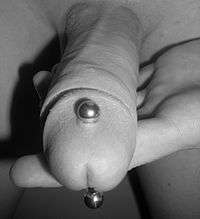Genital piercing


Genital piercing is a form of body piercing. It involves piercing a part of the genitalia, thus creating a suitable place for wearing different types of jewellery. Nevertheless, the term may also be used pars pro toto to indicate all body piercings in the area of anus, perineum, genitals and mons pubis, including piercings such as anal, guiche, and pubic that do not involve perforation of genitalia. Genital piercings can be done in men or women, with various forms of piercings available. The main motive for both genders is beautification and individualization, in addition some piercings enhance sexual pleasure by increasing stimulation.[1][2][3]
History
The traditional heritage place of genital piercings is assumed to be South East Asia, with traditional piercings being found in tribes ranging from India to Borneo. Piercings of the genitals have a long tradition, with sources mentioning the Apadravya, a male genital piercing, as early as in the Kama Sutra (second century).[4]
The ampallang, a similar piercing (which passes horizontally through the glans instead of vertically), is found in different tribes throughout Sarawak and Sabah on the island of Borneo. Genital piercings became first introduced in western countries by ethnographic report, done by explorers such as in the 19th century. The Dutch explorer Anton Willem Nieuwenhuis described in his ethnographic record In Centraal Borneo: reis van Pontianak naar Samarinda - documenting his travel through Borneo in 1897 - the procedure of an ampallang piercing:[5]
″The young men through the tattoo, because it is performed by them only to a limited extent, much less than women to suffer for it but they must in order to gain their full manhood, subject of another test, namely the through-hole the glans penis. This operation procedure is as follows: First, the glans made anemic by pressing between the two arms of a folded over strip of bamboo. At each of these arms are opposite each other where needed openings through which one after the round pressed glans become less sensitive to an acute kapfernen pin; formerly was used for this purpose a pointed bamboo sticks. The bamboo and the clamp is removed by means of a cord attached to pin left in the opening until the channel is healed. Later, the copper pin (utang) by another, usually through a tin, replaced, which is worn at all times, making only heavy work or strenuous operations of the metal pin a wooden square. Particularly brave men enjoy with the chief's prerogative to be allowed to wear the penis a ring in the scales of the pangolin cut and blunt teeth is occupied; sometimes they can also be crossed with the first channel, a second by the glans . Drill In addition to the Kayan themselves, engage in many Malays from the upper Kapuas this art. The pain during surgery do not seem to be very violent, and it has only rarely serious consequences, although until recovery can often take a month.″
Unlike the nipple piercing, that became a short lived fashion trend at the end of the 19th century,[6] genital piercings were uncommon in the western world until the second half of the 20th century. In the 1970s, genital piercings were introduced to the emerging body modification community in Los Angeles by the early piercings pioneers like Jim Ward and Doug Malloy. Genital piercings were sported by the modern primitives movement that developed during the 1980s. Only until the recent years, genital piercing was confined to a body modification subculture.
With the beginning of the 21st century, genital piercing became increasingly more popular, with celebrities such as Janet Jackson,[7] Christina Aguilera,[8] wrestler Katarina Waters,[9] Fantasia Barrino,[10] and Pete Doherty[11] confessing to have or planning to have genital piercings. Genital piercings nowadays have a growing demand, especially in a young adult, college-aged population.[12][13] Marilyn W. Edmunds, adjunct clinical professor at the Johns Hopkins University, states that:[14]
″Women with genital piercings are no longer on the social fringe or part of the "punk" culture who are experimenting with behaviors that are "socially provocative." Over the past 30 years, genital piercing has become mainstream, and women engage in it for a variety of reasons.″
Types of genital piercings
Male genital piercings
Possible piercing sites on the male genitalia include the glans, the skin of the penis shaft, the scrotum or the perineum.
Glans penis
Piercings through the glans of the penis include the ampallang, which passes horizontally, and the apadravya, that passes vertically through the glans. The Prince Albert piercing is situated on the dorsal side while the reverse Prince Albert piercing passes through the ventral side of the glans. The dydoe pierces through the coronal rim of the glans. With the exception of the dydoe, all these piercings traditionally pass through the urethra. This is preferred because the healing time, and incidence of infection is reduced by the flow of sterile urine.[15]
These piercings provide increased stimulation during intercourse to the male (who is carrying the piercing) as well as to the partner. Piercings through the head, or the glans, are the genital piercings with the best-documented historical evidence.[16]
-
Ampallang cropped.jpg
-
Dydoe.jpg
Skin of the penis shaft and scrotum
The foreskin piercing passes through the penile prepuce on the dorsal, ventral or lateral side. It can only be applied if the male is not circumcised. The frenum piercing passes through the penile frenum, a small skin bridge that connects the glans with the shaft skin. This anatomical part is also often missing in circumcised men. The hafada piercing is situated on the skin of the scrotum. As an intermediate version between frenulum and hafada, the lorum piercing (low frenum) sits at the point where penis and scrotum connect. The Jacob's Ladder is a ladder from frenum to scrotum. The guiche piercing is a body piercing on the perineum. These piercings play a lesser role in adding stimulation and more or less fulfill only a decorative purpose.
-
Scrotum piercing.jpg
Female genital piercings
In female individuals as well, various anatomical parts can be suitable for piercings. These incluse the mons pubis, the clitoris (including the clitoral hood), the (inner and outer) labia and the vulval vestibule (which is the area surrounding the vaginal opening).
Clitoris and clitoral hood
The glans of the clitoris itself can be pierced. Since this anatomical part is too small in many cases, this piercing is not very common. In contrast, the clitoral hood piercing is the most common genital piercing for female bodied individuals. It can be applied horizontally and vertically. The deep hood piercing is a variation of the clitoral hood piercing that pass deeper through the clitoral hood. The Isabella piercing passes vertically through the clitoral shaft and is rather complicated to pierce.
-
Pierced.JPG
-
Vertical clitoral hood piercing
-
Hood-piercing.jpg
Horizontal clitoral hood piercing
-

Deep hood piercing
Labia and vulval vestibule
The Labia piercing can be applied at the labia majora or the labia minora. The Triangle piercing is located at the ventral end of the labia minora, at the point of transition between labia and clitoral hood. It runs horizontally, partly under the clitoral shaft. Through the dorsal rim of the vulval vestibule passes the Fourchette piercing. A less common version of the Fourchette is the Suitcase piercing, which can be considered as a deep Fourchette (it enters on the perineum). Also rather uncommon is the Princess Albertina piercing, the female version of the Prince Albert piercing, that passes through the dorsal wall of the urethra.
-

Inner labia piercing
-

Outer labia piercing
Mons pubis
The Christina piercing is a surface piercing, situated on the lower part of the mons pubis where the outer labia meet. It is similar to the Nefertiti piercing, that can be seen as a combination between vertical clitoral hood piercing and Christina piercing.
Motives
Like all other types of body piercing, genital piercings are decorative, appealing to the people wearing them. This can be restricted purely to aesthetic taste or express a sense of uniqueness and non-conformism. Additionally, genital piercings can enhance sexual pleasure during intercourse and masturbation. While female genital piercings do this only to the women wearing them, male genital piercings can enhance stimulation for both the person wearing the jewelry and their partner by stimulating both the glans of the wearer and the vaginal wall or the anus of the penetrated partner. Women of the Dayak in Sarawak prefer men with an Ampallang piercing, claiming that intercourse without would be dull:
The Dayak women have a right to insist upon the ampallang and if the man does not consent they may seek separation. They say that the embrace without this contrivance is plain rice; with it is rice with salt.[17]
For men, the sensitive urethra is stimulated by the jewelry.[2] Female genital piercings that are known to give pleasure are the piercings that pass through or close to the clitoris, i.e. the clitoris piercing and the clitoral hood piercing.[1] The triangle piercing is known to be quite pleasurable by providing stimulation of the underside of the clitoral glans, an area that is usually not stimulated at all.[18]
Legal considerations
In the United States, it is illegal for anyone under 18 to be given a genital piercing. This is because the ministrations involved are considered to fall within the legal definition of molestation. Laws in other countries vary. In many European countries, minors are required to bring a signed consent form from or to be escorted by a legal guardian. Even in countries that have no laws regulating genital piercing in minors, many piercers refrain from doing them (since physiological development is not completed in minors).
See also
References
- 1 2 Does A Clit Piercing Lead To Better Orgasms? 10 Things You Need To Know About Piercing Your Vagina - Bustle
- 1 2 Hogan, K. Rinard, C. Young, A. Roberts, M. Armstrong, T. Nelius (2010); A cross-sectional study of men with genital piercings. British Journal of Medical Practitioners, 3 (2), 315–322. ISSN 1757-8515 Full Text
- ↑ Van der Meer, G., W. W. Schultz, et al. (2008). "Intimate body piercings in women." Journal of Psychosomatic Obstetrics & Gynecology 29(4): 235-239 doi:10.1080/01674820802621874
- ↑ The Apadravya In The Kama Sutra
- ↑ body-modification.com
- ↑ Nipple Piercings, Male and Female - bmezine
- ↑ Janet Jackson’s Interview With Vibe Vixen
- ↑ Female body piercing
- ↑ Piercing genital de Karina Bacchi na Playboy causa polêmica
- ↑ Fantasia’s Pierced Down There - Socialite Life
- ↑ Pete Doherty's penis piercing - Female First
- ↑ E. Kasten (2007): Genitale Body-Modifications bei Frauen. Der Gynäkologe, Volume 40, Number 6, 489-500 doi:10.1007/s00129-007-1985-8
- ↑ VCH Piercings, by Elayne Angel, pp. 16-17, The Official Newsletter of The Association of Professional Piercers
- ↑ Why Women Choose Genital Piercing - Medscape
- ↑ http://www.intimatemedicine.com/sex-in-society/introduction-to-male-genital-piercings/
- ↑ The Point - An Approach to Genital Piercings Part 5
- ↑ Ampallangs and Apadravyas - BMEzine
- ↑ Can selfish lovers ever give as good as they get? - MSNBC
- Anderson, W.R.; Summerton, D.J.; Sharma, D.M.; Holmes, S.A. (2003). "The urologist's guide to genital piercing". BJU International. 91 (3): 245–251. doi:10.1046/j.1464-410X.2003.04049.x. ISSN 1464-4096.
- Bone, A.; Ncube, F.; Nichols, T.; Noah, N. D (2008). "Body piercing in England: a survey of piercing at sites other than earlobe". BMJ. 336 (7658): 1426–1428. doi:10.1136/bmj.39580.497176.25. ISSN 0959-8138. JSTOR 20510103 – via Jstor. (subscription required (help)).
- Esen, U. I (2008). "Health and regulation issues for body piercing". BMJ. 337 (jul08 2): a595–a595. doi:10.1136/bmj.a595. ISSN 0959-8138. JSTOR 20510253 – via Jstor. (subscription required (help)).
- Johnsdotter, Sara; Essén, Birgitta (2010). "Genitals and ethnicity: the politics of genital modifications". Reproductive Health Matters. 18 (35): 29–37. doi:10.1016/S0968-8080(10)35495-4. ISSN 0968-8080. JSTOR 25767326 – via Jstor. (subscription required (help)).
- Myers, J. (1992). "NONMAINSTREAM BODY MODIFICATION: Genital Piercing, Branding, Burning, and Cutting". Journal of Contemporary Ethnography. 21 (3): 267–306. doi:10.1177/089124192021003001. ISSN 0891-2416.
- Ferguson, Henry (1999). "Body Piercing". British Medical Journal. 319 (7225): 1627–1629. doi:10.1136/bmj.319.7225.1627. JSTOR 25186687 – via Jstor. (subscription required (help)).
- Aubrey, Karen (April 1995). "Body Piercing: Gender Nihilism in the 90s". Studies in Popular Culture. Popular Culture Association in the South. 17 (2): 31–37. JSTOR 23413700 – via Jstor. (subscription required (help)).
External links
| Wikimedia Commons has media related to Genital piercings. |
- Elayne Angel: An approach to genital piercings. published by the Association of Professional Piercers:
- General issues
- Clitoral hood and labia piercings
- Prince Albert and pubic piercings
- Frenum, Lorum, Hafada and Guiche
- Foreskin, Dydoe, Ampallang and Apadravya










